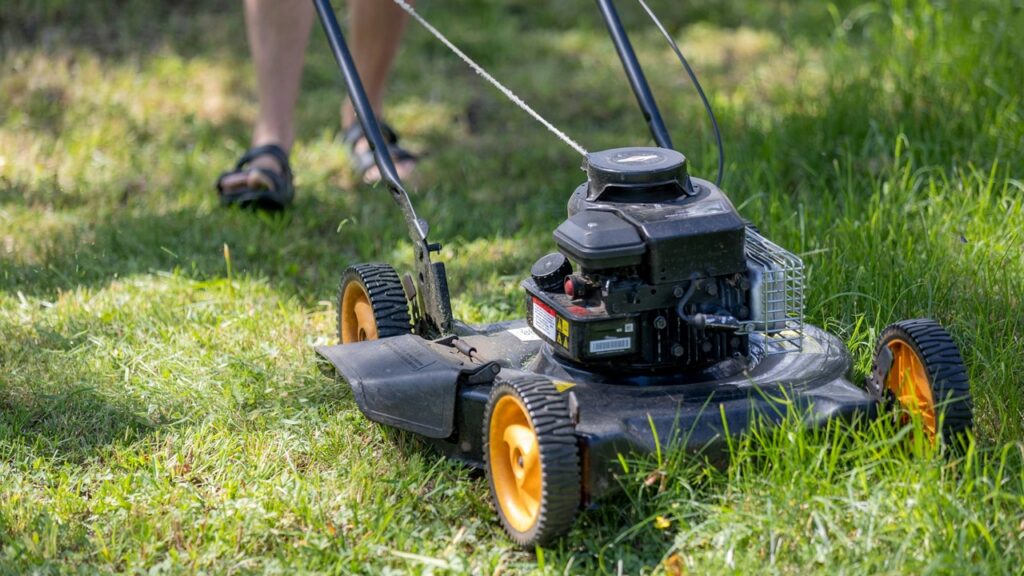
Most lawn mower batteries last between 3 and 5 years. That’s the general rule, but it depends on what type of battery you have, how often you mow, and how well you take care of it.
In this article, we’ll walk you through the average battery lifespan, the different types of lawn mower batteries, and what affects how long they hold up.
You’ll also learn which type might be best for your needs and how to make your battery last longer. Whether you’re new to mowing or replacing a dead battery, this guide should make things easier.
What’s the Average Lifespan of a Lawn Mower Battery?
Most lawn mower batteries are built to last about 3 to 5 years. Some may die out earlier, while others hang on a little longer—especially if they’re high quality and well taken care of.
The actual lifespan depends on a few things, like the battery type, your mowing habits, and how you store or charge it.
For example, lead-acid batteries are more affordable but tend to wear out faster. Lithium batteries cost more upfront, but they’re known to outlast their lead-acid cousins and need less attention.
If your mower battery doesn’t hold a charge or dies halfway through mowing, it might be time for a replacement—even if it hasn’t hit the 3-year mark yet.
How Long Does a Lawn Mower Battery Last?
Lead-acid batteries last around 2 to 4 years, and lithium-ion batteries can go 5 years or more with good care. Some newer lithium options, like LiFePO4, can even last up to 10 years.
That said, lifespan isn’t just about the calendar. Batteries age faster when exposed to extreme heat or cold, when they’re left sitting too long without use, or when they’re overcharged. Even the best battery won’t last if you forget about it all winter or leave it out in the sun after mowing.
So, if you’re wondering how long your battery will last, the real answer is: it depends on how you treat it.
Types of Lawn Mower Batteries and How Long They Last
Lawn mower batteries usually fall into one of three categories. Each comes with its own lifespan, maintenance needs, and cost.
1. Lead-Acid Batteries
Lead-acid batteries are the old-school option. You’ll often find them in riding mowers or budget push mowers. These batteries typically last 2 to 4 years if you keep them charged and clean.
They’re fairly cheap to replace, but they do need regular maintenance. That means checking for corrosion, topping off fluids (if needed), and storing them properly in the off-season.
Pros:
- Lower upfront cost
- Easy to find and replace
- Suitable for basic mowers
Cons:
- Heavier and bulkier
- Needs regular maintenance
- Shorter lifespan than lithium options
2. Lithium-Ion Batteries
Lithium-ion batteries are now the go-to choice for many modern cordless mowers. With a lifespan of 4 to 6 years (sometimes more), they’re built to be efficient and reliable.
They’re lightweight, charge faster, and don’t need much maintenance. Just charge it up and go. But they do cost more, and extreme heat or cold can still cause problems.
Pros:
- Longer lifespan than lead-acid
- Lightweight and fast charging
- Maintenance-free
Cons:
- More expensive
- Sensitive to high heat
3. LiFePO4 Batteries (Advanced Lithium)
LiFePO4 batteries are a newer type of lithium battery. They can last 8 to 10 years, sometimes even longer if you don’t push them too hard.
They’re safer, more stable in high temperatures, and ideal for those who want to make a long-term investment. These batteries are common in higher-end mowers and even solar setups.
Pros:
- Extremely long lifespan
- Great heat resistance
- Very stable and safe
Cons:
- Higher upfront price
- Not compatible with all mowers
What Affects Lawn Mower Battery Lifespan?
How long your lawn mower battery lasts doesn’t just depend on what kind it is. It also comes down to how you use it, charge it, and store it between mowing seasons.
Charging Habits
How you charge your battery makes a big difference. Overcharging, undercharging, or forgetting to charge it at all can slowly wear it out.
If you’re using a lead-acid battery, don’t let it sit around discharged for long periods—it can cause sulfation, which ruins the battery.
Lithium-ion batteries are more forgiving but still do best when kept between 20% and 80% charge. Using a smart charger can help prevent mistakes and keep your battery healthier for longer.
Usage Frequency and Conditions
The more you mow, the more your battery works. That’s normal. But mowing through thick, wet, or overgrown grass puts extra strain on the motor, which drains the battery faster.
If you mow often or on challenging terrain, expect your battery to go through more charge cycles and wear out sooner. On the other hand, letting a battery-powered mower sit unused for long periods without charging can be just as harmful.
Temperature Extremes
Heat and cold can be tough on batteries. If your mower is kept outside in the sun or used in freezing weather, the battery won’t last as long.
Hot temperatures speed up internal wear, and cold weather can make the battery sluggish or stop it from charging properly. Try to mow in mild conditions and store your battery in a climate-controlled space if you can.
Storage During Off-Season
When mowing season is over, what you do with your battery matters. Leaving it in the mower or in a cold shed can reduce its lifespan.
Lead-acid batteries should be stored fully charged, while lithium-ion batteries should be stored with a partial charge, usually around 50%. Always store batteries in a dry, cool place, away from direct sunlight or moisture.
Battery Quality and Brand
Not all batteries are created equal. Cheaper options might work fine at first, but they usually wear out quicker and don’t hold up well under heavy use.
Trusted brands may cost more upfront, but they tend to offer better durability, safety features, and longer lifespans. It’s one of those “you get what you pay for” situations.
How to Tell If Your Lawn Mower Battery Is Going Bad
If your mower isn’t running like it used to, your battery might be the reason. Here are some common signs to watch for:
- No sound when starting: If you turn the key or press the button and hear nothing, your battery might be dead.
- Engine cranks slowly or not at all: A weak battery may struggle to power the starter.
- Dim or flickering lights: If your mower has headlights, and they’re dim or flickering, it’s usually a power issue.
- Battery won’t hold a charge: If you charge it fully and it dies again quickly, that’s a red flag.
- Visible corrosion or swelling: Check for white buildup on the terminals or any bulging on the battery case.
- Voltage reads low: Use a multimeter—below 12.4 volts for a lead-acid battery often means it’s time to replace it.
When to Replace Your Lawn Mower Battery
You should replace your lawn mower battery every 3 to 5 years, depending on the type and how it’s been maintained. If it’s not holding a charge or showing signs of wear, it’s likely on its last legs.
Even a good battery won’t last forever. If you’ve already tried cleaning the terminals, recharging properly, and storing it right, but the mower still struggles to start, it’s probably time to shop for a new one. Don’t wait until it leaves you stuck halfway through mowing your yard.
Keep in mind that lead-acid batteries tend to wear out sooner than lithium ones. If you’re replacing yours often, it might be worth investing in a longer-lasting lithium or LiFePO4 battery for the long haul.
How to Make Your Lawn Mower Battery Last Longer
A little care goes a long way when it comes to battery life. If you want to avoid replacing your lawn mower battery too soon, follow these simple habits.
Keep Terminals Clean
Dirty or corroded terminals can interrupt the power flow and make your battery work harder than it needs to. Every few weeks, check the terminals and brush off any white buildup or rust using a mix of baking soda and water.
After cleaning, apply a small dab of petroleum jelly to prevent future corrosion. Always disconnect the battery before cleaning.
Charge Properly
How you charge your battery matters just as much as how often. Avoid letting it fully drain or stay on the charger too long. Use a smart charger if possible, as it stops charging when the battery is full.
For lead-acid batteries, try to keep them fully charged. For lithium-ion, keeping the charge between 20% and 80% helps extend its life.
Store Correctly Over Winter
When mowing season ends, don’t just park your mower and forget about the battery. Remove it and store it in a cool, dry spot—preferably indoors.
Lead-acid batteries should be stored fully charged, while lithium batteries do better with a partial charge. Avoid storing your battery in a freezing garage or humid shed.
Inspect Regularly
Every now and then, take a few minutes to look over your battery. Check for cracks, swelling, or any weird smells. These are signs the battery is failing.
Also, keep an eye on performance—if your mower seems weaker or runs out of juice faster than usual, it might be time for a new one.
What to Do With a Dead Lawn Mower Battery
Once your battery is done, don’t toss it in the trash. Dead mower batteries contain materials that can harm the environment if not disposed of properly.
- Recycle it: Many auto shops, home improvement stores, and battery retailers accept used batteries for recycling.
- Use manufacturer return programs: Some mower or battery brands offer take-back programs when you buy a replacement.
- Check local disposal rules: Your local waste management department may have a drop-off site for old batteries.
Proper disposal keeps hazardous materials out of landfills and helps reclaim valuable components like lead or lithium.
Conclusion
So, how long does a lawn mower battery last? On average, you’re looking at about 3 to 5 years—sometimes longer if it’s a lithium battery and you treat it well. Things like how you charge, store, and care for your battery play a big role in how long it sticks around.
Choosing the right type of battery, cleaning the terminals, storing it properly during the off-season, and catching problems early can all help extend its life.
And when your battery does call it quits, recycling it the right way is the smart move.
FAQs
How often should I replace my mower battery?
Most people replace their lawn mower battery every 3 to 5 years. If you notice weak starts, short run times, or it won’t hold a charge, it’s probably time.
What’s the longest-lasting type of battery for lawn mowers?
LiFePO4 (Lithium Iron Phosphate) batteries last the longest—up to 8 to 10 years. They’re pricey, but they hold up better over time and in tough conditions.
Can I use any 12V battery for my mower?
Not always. Make sure the battery matches your mower’s voltage and physical size. Check the owner’s manual or the old battery label to find the right type.
Does winter storage affect battery life?
Yes, big time. Leaving your battery in freezing temps or fully drained can shorten its life. Store it charged (or partially charged for lithium), in a dry, cool place.
Can a lawn mower run without a battery?
Only some gas-powered push mowers can run without a battery. If your mower has electric start or is battery-powered, it won’t run without one.

At our core, we’re a group of passionate yard, garden and mown enthusiasts. We dive deep into the world of backyard of your home. We try to provide as much value to the readers with our information and how to blog articles as possible along with proper information-based reviews as well.




